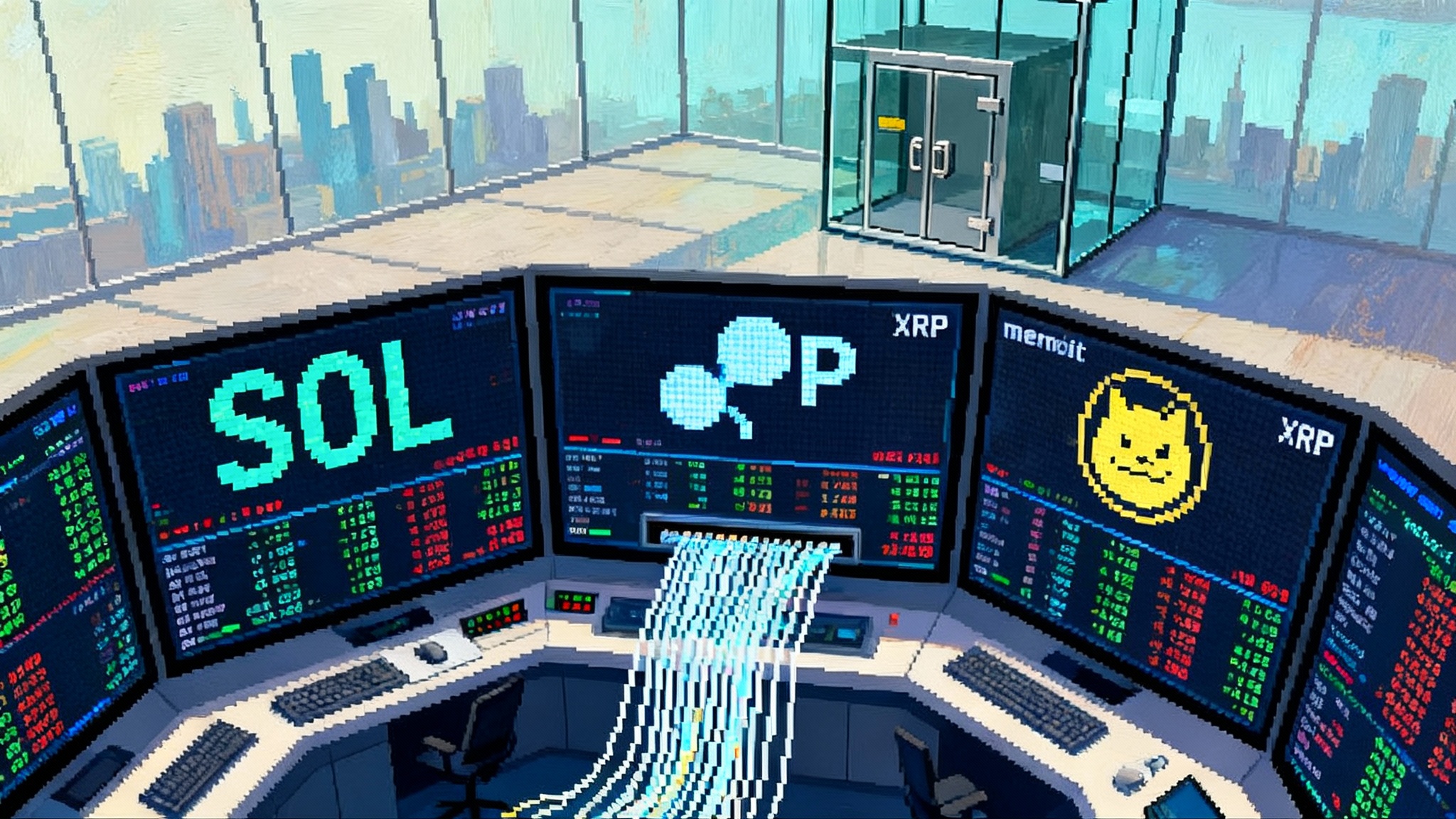Altcoin ETFs Are Coming: How New SEC Rules Reshape Crypto
The SEC just cleared a fast track for spot ETFs beyond bitcoin and ether. Here is how generic listing standards set up Solana and XRP first, what it means for liquidity, custody and staking, and who wins as Q4 2025 nears.

The rules that changed overnight
The market has been waiting for a clear bridge from bitcoin and ether to the rest of crypto. On September 18, 2025, the SEC approved generic listing standards that let exchanges list certain spot digital asset ETFs without bespoke, case by case rule filings. The change shortens the path from concept to trading and opens the door for issuers to bring Solana, XRP and other tokens into registered ETF wrappers. It replaces the slow dual track of exchange rule approvals and registration statement reviews with a simpler framework and a faster clock. According to early reporting, listings could happen in as little as 75 days under the new process, with some products potentially live before the end of October. That is a structural break from the last decade of crypto ETP policy and it matters for everything from order routing to custody revenue to staking design. SEC approves generic listing standards.
What “generic listing” really means
Until now, a spot crypto ETF needed two green lights. First, an exchange had to get its product specific rule change approved under Section 19(b)(1). Second, the issuer’s S-1 or Form N-1A had to go effective. That was duplicative and unpredictable. Generic standards let an exchange list a new commodity based spot ETF so long as the product fits pre approved criteria baked into the exchange rulebook. The exchange no longer files a new 19b-4 per token. The issuer still needs an effective registration statement, but the overall timeline compresses, and review focuses on disclosure quality rather than one off arguments about surveillance and market manipulation.
For crypto, the criteria most likely hinge on two pillars:
- Surveillance and market integrity. Exchanges can point to regulated reference markets and surveillance sharing arrangements to detect manipulation. The generic standards make that evidentiary burden repeatable rather than bespoke.
- Product design guardrails. Clear rules on creation unit size, daily NAV dissemination, and which counterparties can participate as authorized participants keep products operating like other commodity based trust shares.
That makes the process more mechanical. If an issuer meets the tests, it lists. If not, it waits.
Why Solana and XRP leap to the front of the line
Generic listing is token agnostic. In practice, the first movers will be assets that already have a regulated derivatives footprint and an established spot market in the U.S. That is why Solana and XRP are positioned well.
- Solana has a regulated futures market at CME. That gives exchanges and issuers a deep, surveilled venue for hedging, pricing and cross market integrity analysis. CME launched Solana futures in March 2025.
- XRP gained its own regulated futures at CME in May 2025, and the long running Ripple case that clouded U.S. distribution effectively concluded in August 2025. Together, those steps make the market structure for XRP much more conventional in the eyes of regulators and risk managers.
Tokens with both regulated derivatives and broad spot depth can support the ETF ecosystem on day one. That includes hedging for market makers, reference rates for administrators, and a surveillance venue that exchanges can monitor in tandem with spot data feeds.
Yes, even memecoins could show up
Memecoin ETFs are no longer a punchline. Under generic listing, the constraint is not branding but whether the asset meets the rulebook tests. The most important threshold will be market integrity. If a single token lacks a regulated futures market or a credible surveillance partner, the first wave is more likely to be a diversified basket that spreads manipulation risk across multiple names and caps concentration. As regulated derivatives expand, single asset memecoin funds will become more plausible. Expect filing creativity in the meantime, including rules based baskets that overweight the most liquid, exchange eligible names and rebalance on a public schedule.
Liquidity mechanics: how flows will actually work
ETFs live or die on primary market plumbing. The new standards will not change the core design of crypto commodity trusts, but they reshape the speed and the participants.
- Creation and redemption method. The first launches will likely use cash creations and redemptions. Authorized participants deliver cash to the trust. A lead market maker or an affiliate executes spot purchases across qualified venues and delivers the token to the custodian. This keeps AML and KYC clean and centralizes on chain handling with the custodian.
- Hedging loop. During the creation window, market makers hedge with regulated futures and highly liquid spot pairs. For Solana and XRP, the presence of CME futures reduces basis risk and allows tighter spreads in the ETF. The classic arbitrage loop develops quickly: ETF shares rich to NAV lead to creations, which lead to spot buys and futures unwinds; discounts do the reverse.
- Secondary market depth. Once live, spreads compress to the combined cost of hedging plus fees. If regulated futures are liquid and custody transfers are predictable, spreads can look similar to gold or silver ETFs even on day two.
What changes for the underlying token markets? Two effects matter:
- Price discovery migrates at the margin. ETF prints during U.S. hours join CME futures and the most liquid spot venues in setting the tone. Lead lag effects between on chain venues and the ETF will be tradable.
- Volatility dampens around the open and close. Standardized creation windows and closing auctions anchor liquidity, which can smooth intraday whip saws that plague smaller tokens.
Custody is no longer exotic
Custody for single asset crypto ETFs has matured. Expect the playbook to match bitcoin and ether ETFs, with adjustments for token idiosyncrasies:
- Qualified custodians with SOC 1 and SOC 2 reports. Cold storage and multi party computation for hot wallets. Dual control and hardware security modules. Daily reconciliation against on chain addresses.
- Segregation and bankruptcy remoteness. The trust’s on chain addresses are separate from the custodian’s corporate assets, and the trust owns the private keys or controls access under a tri party agreement.
- Insurance and incident response. Policy limits likely focus on cold storage with exclusions for hot wallet losses. Incident playbooks include chain reorgs, validator downtime, and exchange outages.
Unique wrinkles do exist. Solana’s account model and authority delegation need careful key management, especially for staking or governance interactions. XRP Ledger has reserve requirements and destination tags that must be handled by the administrator. None of this is unsolved, but the ops runbook needs to be designed token by token, not copied from bitcoin.
Staking: the big fork in the road
Will these ETFs stake? Not at first. The SEC has been consistent that staking in a 1933 Act commodity trust complicates the structure. Staking introduces counterparty and operational risk and raises questions about whether the fund is running an enterprise rather than passively holding a commodity. It also introduces yield that looks like income, with complex tax and distribution consequences.
Issuers will start with simple spot exposure. Two later developments are possible:
- A separate share class or a sibling fund that shares staking yield with holders, once the Commission is comfortable with the custodian and validator controls. That will take time.
- A service model in which the trust receives protocol emissions but does not delegate actively. This is possible on some chains, but many networks require explicit delegation and slashing risk management, which pulls the fund toward an operating role.
The near term result is counterintuitive. If ETFs cannot stake, circulating staked supply stays outside the funds, which can increase on chain staking yields for native participants. That reinforces DeFi’s role as the yield venue while the ETF becomes the price exposure venue.
Fees, taxes and tracking error
The fee war that we saw in bitcoin will reprise. Expect headline fees to compress quickly toward 0.20 to 0.40 percent once three or more issuers list. Tracking error should be tighter than offshore ETPs thanks to regulated futures for hedging and stronger cash management. For taxes, most of these vehicles will be grantor trusts for U.S. investors. Gains and losses flow through, and wash sale rules may not apply directly to the token, though investors should not assume bitcoin rules map perfectly to other assets. Issuers will publish tax opinions in the S-1, and those will drive advisor guidance.
A realistic timeline from today to Q4 2025
Here is the base case from the new rules to first bell:
- Week 0 to 2. Listing venues publish their generic standards implementation notices. Issuers update existing filings to conform to the new framework. Authorized participants sign their agreements and begin test creations.
- Week 3 to 6. The SEC staff cycles comments on disclosure, risk factors and operations. Administrators finalize daily NAV calculation, reference rate sources, and dissemination.
- Week 6 to 10. S-1s go effective. Launch dates are set with lead market makers. Seed capital is wired, and initial baskets are created.
- Week 10 to 12. First products list. If an issuer already had a mature filing under the prior regime, an October or November launch is plausible. A conservative base case is late Q4 for the first Solana and XRP funds, followed by baskets of smaller names.
Supply chain bottlenecks are still possible. A short roster of qualified custodians and administrators can slow onboarding. So can the need for robust reference rates that blend U.S. and offshore spot venues without over relying on any one exchange for pricing.
Winners and losers across the stack
Winners
- U.S. listing venues. Cboe, Nasdaq and NYSE gain product count and trading hours that pull price discovery onshore. Closing auctions become important again for crypto.
- CME Group. Each new token with regulated futures becomes easier to hedge and surveil. That lifts futures volume and options demand while tightening ETF spreads.
- Large custodians and administrators. Coinbase Custody, Fidelity Digital Assets, BitGo, Anchorage and a handful of others stand to capture asset based fees and operational float.
- Authorized participants and lead market makers. The firms that can warehouse token inventory, run cross venue algos and manage futures basis will earn creation spreads and capture order flow.
- Retail brokerages and RIAs. A spot ETF is the easiest bridge to crypto exposure inside existing portfolios and compliance tools. It brings crypto into model portfolios and 401(k) windows without new plumbing.
- DeFi on the strongest chains. If ETFs do not stake, native yields stay higher for on chain users. Liquidity venues that specialize in token ETF pairs can thrive as arbitrage routers.
Losers
- Offshore exchanges that rely on U.S. retail. Clean, cheap ETF exposure will siphon some incremental buyers away from offshore spot venues that lack strong compliance programs.
- Closed end funds and high fee trusts. As true ETFs list, legacy vehicles with discounts or high fees will bleed assets.
- Long tail tokens without regulated derivatives. The gap between ETF eligible and non eligible assets will widen. Index providers will face pressure to cap weights and prune constituents.
- Centralized staking programs at exchanges. If ETFs become the default buy button, exchange staking will fight for attention against a passive ETF that does not offer yield but does offer simplicity.
How liquidity, spreads and volumes may evolve
Day one spreads will be wider than bitcoin’s because the underlying markets are thinner and the creation chain is new. As futures and ETF volumes build, spreads should compress toward 10 to 20 basis points in normal conditions. The presence of U.S. regulated futures for Solana and XRP is the key. It lets market makers hedge creations and redemptions across time zones and keep inventory lean.
Volumes will center on U.S. hours at first. As Europe and Asia list copycat products, two way flow improves, which further tightens U.S. spreads. Expect the open and close to become the highest liquidity windows, with mid day lulls similar to equities.
One risk to watch is reference rate fragility. If an ETF’s pricing basket leans too hard on any one spot exchange or a thin pair, intraday NAVs can jump. Issuers will need redundancy across venues and a clear playbook for outlier prints.
What to watch next
- Which exchange posts its generic standards first, and how strict the eligibility tests are for digital assets.
- The first S-1 to receive effectiveness, and whether cash creations remain the norm or in kind becomes possible later.
- Expense ratios and seed sizes. Low fees and large seeds make for tighter spreads.
- AP and market maker rosters. More participants equals better price competition.
- Any attempt to include staking. Even a small pilot would be a sea change.
The bottom line
The SEC’s generic listing standards are a market structure unlock. They turn the altcoin ETF story from a political guessing game into an operational race. Assets with regulated futures, deep spot books and clean custody will sprint ahead. That puts Solana and XRP on the front row, with baskets of other names and, eventually, single asset memecoin funds not far behind. The plumbing is familiar. The incentives are strong. If filings stay on schedule, Q4 2025 could be the quarter when crypto ETFs stop being a bitcoin story and start looking like an asset class.


